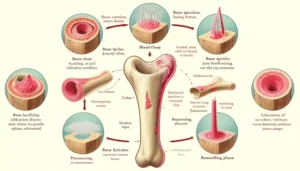Sublocade Opioid Treatment: A Guide to Opioid Use Disorder

Opioid use disorder is a serious and complex issue that affects millions of individuals around the world. One treatment option that has gained popularity in recent years is Sublocade, a long-acting injectable medication designed to help manage cravings and withdrawal symptoms. However, with any medical intervention, there are both benefits and risks to consider. In this blog post, we’ll be unpacking the pros and cons of Sublocade opioid treatment so that you can make an informed decision about your healthcare journey.
Introduction to Sublocade Treatment and Opioid Use Disorder (OUD)
Is opioid use disorder (OUD) affecting you or someone you care about? If so, you’re not alone. The grip of addiction can feel overwhelming, but there is hope on the horizon in the form of Sublocade Treatment. In this blog post, we will delve into the benefits and risks of Sublocade as a groundbreaking solution for individuals seeking to break free from the chains of opioid dependence. Let’s unpack the power of Sublocade Treatment and explore how it could be a game-changer in your journey toward recovery.
What is Sublocade and How Does it Work?
Sublocade is a prescription drug used for managing opioid addiction. Unlike daily oral medications, Sublocade is administered monthly, providing a sustained release of buprenorphine over time. This helps in reducing cravings and withdrawal symptoms associated with OUD.
Sublocade functions by binding to the same brain receptors as opioids, but it does not produce the same euphoric effects. By doing so, it helps to normalize brain chemistry and reduce the negative impact of opioids on the body.
This long-acting form of buprenorphine offers convenience for individuals seeking treatment for OUD. With just one monthly injection, patients can experience continuous therapeutic effects without remembering daily doses or refills.
Benefits of Sublocade Treatment for OUD
If you or someone you know is battling opioid use disorder (OUD), Sublocade treatment could be a game-changer. One of the primary benefits of Sublocade is its ability to reduce cravings and withdrawal symptoms, making the journey to recovery more manageable. By providing a steady dose of medication over time, Sublocade helps lower the risk of relapse, giving individuals a better chance at long-term sobriety.
Moreover, the convenience and ease of use of Sublocade treatment are significant advantages for those in recovery. Instead of having to remember daily medications or appointments for dosing, Sublocade offers a monthly injection that healthcare professionals can administer.
These benefits make Sublocade an attractive option for individuals seeking effective OUD treatment with reduced risks and enhanced convenience.
Reduction in Cravings and Withdrawal Symptoms
For those struggling with opioid use disorder (OUD), persistent cravings and intense withdrawal symptoms can pose significant challenges on the path to recovery. This is where Sublocade treatment steps in as a game-changer. By delivering a steady dose of buprenorphine over an extended period, Sublocade helps to reduce these intense cravings significantly.
The gradual release of medication through a monthly injection ensures that patients experience fewer highs and lows associated with other forms of medication-assisted treatment. This stabilization improves physical well-being and provides much-needed mental relief from the constant battle against cravings.
Moreover, by effectively managing withdrawal symptoms like muscle pain, nausea, insomnia, and anxiety, Sublocade creates a smoother path toward sobriety for individuals seeking lasting recovery from OUD. The reduction in both cravings and withdrawal symptoms plays a crucial role in empowering patients to regain control over their lives and break free from the grips of addiction.
Lower Risk of Relapse
When it comes to overcoming opioid use disorder (OUD), one of the significant challenges individuals face is the risk of relapse. This can be a daunting prospect for those on the path to recovery, as relapsing can set back progress and lead to feelings of discouragement.
However, with Sublocade treatment, there is a promising reduction in the risk of relapse. The medication works by blocking the effects of opioids in the brain, helping to control cravings and withdrawal symptoms that often trigger relapses.
By receiving regular Sublocade injections as part of a comprehensive treatment plan, individuals have reported experiencing fewer urges to use opioids and an increased ability to maintain sobriety. This lower risk of relapse offers hope and support for those striving toward long-term recovery from OUD.
Overall, the reduced likelihood of relapse associated with Sublocade treatment highlights its potential as an effective tool in supporting individuals on their journey toward lasting sobriety.
Convenience and Ease of Use
Sublocade provides a convenient and easy-to-use treatment option for people with opioid use disorder. Unlike daily medication regimens, Sublocade is administered once a month via injection by a healthcare provider. This eliminates the need to remember to take pills every day, providing a hassle-free experience for patients.
The simplicity of receiving Sublocade treatments can help individuals maintain consistency in their recovery journey without the burden of frequent clinic visits or pharmacy pickups. This streamlined approach allows patients to focus more on their well-being and progress toward sobriety.
Moreover, the simplicity of Sublocade injections can enhance treatment adherence, resulting in better management of opioid cravings and withdrawal symptoms. Overall, the convenience offered by Sublocade may contribute positively to an individual’s commitment to long-term recovery.
Risks and Side Effects of Sublocade Treatment
When considering Sublocade treatment for opioid use disorder, it’s essential to be aware of the potential risks and side effects that may accompany this form of therapy. Like any medication, Sublocade comes with its own set of possible drawbacks.
One common risk associated with Sublocade treatment is injection site reactions. Pain, redness, or swelling at the injection site may be among the possible reactions. While these symptoms are usually mild and temporary, they can still be bothersome for some individuals.
In addition to injection site reactions, other side effects of Sublocade may include nausea, headaches, and dizziness. The severity of these manifestations can differ among individuals. As the body adapts to the medication, these effects may diminish over time.
It’s essential to discuss any concerns about potential risks and side effects with a healthcare provider before starting Sublocade treatment. Your doctor can provide personalized advice based on your health history and individual needs.
Injection Site Reactions
Sublocade treatment for opioid use disorder offers a promising solution, but like any medical intervention, it comes with potential risks. One common issue reported by some individuals undergoing Sublocade treatment is injection site reactions. These reactions may appear as redness, swelling, or discomfort at the injection site where the medication is given.
While injection site reactions are generally mild and temporary, they can still be uncomfortable for some patients. Communicating any concerns or unusual symptoms to your healthcare provider promptly is essential. They can guide you in managing these reactions and ensure you receive proper care throughout your treatment journey.
Keep in mind that each person’s body responds differently to medications, so one individual’s experience may vary from another’s. Monitoring your injection sites and communicating with your healthcare team are crucial steps in ensuring a smooth and practical Sublocade treatment experience.
Nausea, Headaches, and Dizziness
It’s essential to weigh the benefits and risks of Sublocade treatment for opioid use disorder. While Sublocade can significantly reduce cravings, lower the risk of relapse, and offer convenience in treatment, it is essential to consider potential side effects like injection site reactions, nausea, headaches, and dizziness.
Before starting Sublocade treatment, consult with a healthcare provider who specializes in addiction medicine. They can evaluate your needs and help decide if Sublocade is the right choice. Remember that overcoming opioid use disorder is a journey that needs continuous support and guidance.
With proper medical supervision and commitment to the treatment plan, Sublocade can be a valuable tool in overcoming opioid addiction. Take control of your health and discover the options for Sublocade treatment available in your area.
Frequently Asked Questions (FAQs):
How long does Sublocade treatment typically last?
Sublocade treatment duration can vary depending on individual needs and responses. Generally, treatment can last for several months to years to provide long-term support and stability in opioid addiction recovery. It is essential to consult with your healthcare provider to determine the most suitable treatment duration for your specific situation.
Are there any side effects associated with Sublocade?
As with any medication, Sublocade may cause potential side effects. Common side effects may include constipation, nausea, headache, injection site reactions, and insomnia. It is crucial to discuss any concerns or experiences of side effects with your healthcare provider, as they can provide guidance and support throughout your treatment journey.
Can Sublocade be used with other medications or therapies?
Sublocade can be combined with other medications and therapies as part of a comprehensive treatment plan. You must inform your healthcare provider about any medications or therapies you are currently undergoing to ensure they can assess the compatibility and potential interactions with Sublocade.
Does Insurance cover Sublocade?
Insurance coverage for Sublocade treatment may differ based on your provider and the specifics of your policy. Many insurance plans cover Sublocade, but you should contact your insurance company to verify coverage and understand potential requirements or restrictions.
What steps should I follow if I miss a scheduled Sublocade injection?
If you miss a scheduled Sublocade injection, contacting your healthcare provider as soon as possible is crucial. They will guide you on the next steps, which may involve rescheduling the injection or adjusting your treatment plan accordingly. It is essential to consult a healthcare professional before administering additional doses or changing your treatment.
Can Sublocade be used as a standalone treatment or with other therapies?
Sublocade can be used as a standalone treatment and with other therapies, depending on individual needs and circumstances. Your healthcare provider will assess your situation and recommend the most appropriate treatment approach to maximize your chances of successful recovery.
Will Sublocade show up in drug tests?
Sublocade contains buprenorphine, which is an opioid. In standard drug tests, it may be detected as an opioid. However, it is essential to note that Sublocade is a prescribed medication for opioid addiction treatment and should be disclosed to the entity conducting the drug test. Accurate interpretation of the results can be supported by maintaining proper documentation and clear communication with the testing facility.
Are there any dietary restrictions while on Sublocade?
There are no specific dietary restrictions associated with Sublocade. However, it is always advisable to maintain a healthy and balanced diet to support overall well-being during the recovery process. Your healthcare provider may provide specific guidance based on your needs and potential interactions with other medications or conditions.
Can Sublocade be used for long-term maintenance?
Yes, Sublocade can be used for long-term maintenance as part of a comprehensive treatment plan for opioid addiction. Long-term use of Sublocade can provide ongoing support and stability, helping individuals maintain their recovery and reduce the risk of relapse. Your healthcare provider will determine the optimal duration for your treatment based on your progress and individual circumstances.
Is Sublocade Suitable for Everyone?
While Sublocade is a valuable treatment option, it may not suit everyone. Individuals with a known hypersensitivity to buprenorphine or experiencing acute or severe respiratory depression should avoid Sublocade. Furthermore, pregnant individuals or those planning to become pregnant should consult with their healthcare provider regarding the potential risks and benefits of Sublocade during pregnancy.
What should I expect during the Sublocade injection procedure?
A healthcare provider will give the Sublocade injection as a subcutaneous shot, usually in the abdominal area. The injection is performed once a month. The method is relatively quick and generally well-tolerated. It is essential to follow the instructions provided by your healthcare provider and communicate any concerns or questions you may have before, during, or after the injection.
It’s important to consult your healthcare provider for personalized advice and information about Sublocade treatment. They are best equipped to address your unique needs and support you throughout your recovery journey.
Conclusion
Sublocade provides a promising and effective treatment option for those battling opioid addiction. Individuals can make informed decisions regarding their recovery journey by understanding its mechanism of action, benefits, and considerations. Remember, Sublocade is just one tool on the path to recovery, and the support of healthcare professionals, therapy, and a robust support system is crucial for lasting success. If you or someone you know is battling opioid addiction, consider exploring Sublocade as a potential avenue for recovery.






